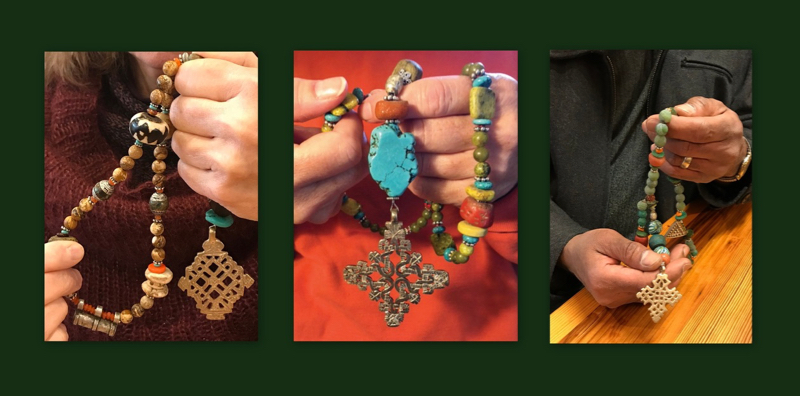I was three or four years old when I met my first set of prayer beads. The buff-colored rosary beads coiled cobra-like on the nightstand of my best friend and next door playmate Marian. In the daytime the plastic rosary was not much to look at: a string of plain lentil-sized beads with one nubby large bead and an inch-long crucifix dangling at the end. But after dark, the rosary transformed. When the lights went out, that boring-by-day rosary glowed. Frequent sleepovers on an army cot next to Marian’s twin bed exposed me to the mysterious glow. When darkness filled the room, the whole snaky community of beads cast an eerie bright-green halo of light over our beds. These nights were my magical introduction to both rosaries and florescence.
 For years, I coveted the glow-in-the dark rosary, even though I knew that both coveting and rosaries were bad. Coveting, because it was a violation of the tenth commandment, and rosaries, because they were Catholic. And all things Catholic were suspect and not for us. My family was Protestant. Marian’s family was Catholic. Every room in their house proclaimed their religion. Crucifixes, beads, and plastic statues of Jesus, Mary, and saints hung on walls and sat on dressers. In her parent’s bedroom, a large crucifix spread its arms on the wall next to the bed. The blood on the hands and feet creeped me out a little, but also encouraged my childhood fascination with bodily fluids. Above the headboard of that same bed was a Polish Black Madonna.
For years, I coveted the glow-in-the dark rosary, even though I knew that both coveting and rosaries were bad. Coveting, because it was a violation of the tenth commandment, and rosaries, because they were Catholic. And all things Catholic were suspect and not for us. My family was Protestant. Marian’s family was Catholic. Every room in their house proclaimed their religion. Crucifixes, beads, and plastic statues of Jesus, Mary, and saints hung on walls and sat on dressers. In her parent’s bedroom, a large crucifix spread its arms on the wall next to the bed. The blood on the hands and feet creeped me out a little, but also encouraged my childhood fascination with bodily fluids. Above the headboard of that same bed was a Polish Black Madonna.
Well-meaning Protestants told me that Catholics worshiped these objects instead of God. Idolatry was the spelling bee word I learned to describe this practice. Maybe a few Catholics misused and worshiped them, but flash forward a few decades or so into the future, and I have a different understanding of rosaries and statues and icons. Before the average person could read or had access to a Bible in their house, they needed ways to remember the stories, ways to learn the traditional prayers of the Church. Rosaries, crosses, and statues provided visual, kinesthetic, and tactile ways to remember the salvation story. Always within eyeshot, these religious objects/tools reminded people who they were as Christians and prompted them to pray unceasingly. Even though most Western Christians–Catholics and Protestants alike– now have at least one Bible in their homes, the sacred objects of beads, crucifixes, and statues honor the different ways people receive and hold information in their brains. Being a Christian is not just about the using the head and saying words, but a whole body experience. The miracle of the past few decades is the exchange of practices between Catholics and Protestants. More Catholics study and memorize Scripture; more Protestants wear crosses, display religious art, and use prayer beads.
Suzanne Henley is one of those lifelong Protestants who understands the purpose and power of the ancient practice of praying with beads. In her new book Bead by Bead: The Ancient Way of Praying Made New, Suzanne is an engaging historian, jarring theologian, reluctant prayer warrior, and true confessions writer. Her book celebrates the beauty and significance of a bead by bead ritual of prayer. With both reverence and tenderness, she describes how these small pieces of stone, glass, and metal string together to become a visual and tactile prayer practice used by billions of people over thousands of years. As the creator of hundreds of sets of prayer beads herself, Suzanne literally prays them into existence one bead at a time.*

The step-by-step instructions and prayer liturgies in this book focus on Protestant prayer beads, a late 20th-century adaptation of the Catholic rosary. But the goal of Bead by Bead is more than just introducing the reader to this ancient practice of prayer. With or without beads, Suzanne wants us to march out the doors of our houses and our closed minds to see the whole world as a giant set of prayer beads. She wants us to see every object and every moment in our lives as an opportunity to count blessings, express awe, pray for others, and examine our lives. As a true Southern raconteur who is not afraid to reveal her fumbling efforts at life and prayer, her stories of seeing God on every corner, in the produce section at the grocery, and on a bright white Harley delight and wrench the heart.
I now have my own glow-in-the dark rosary from a Catholic bookstore and a set of Protestant prayer beads made by Suzanne. I’m not a regular bead pray-er with either, but each serves as a different kind of prayer prompt for me. The rosary hangs on the lampshade next to my bed. As I turn out the light, its glow tells me to say goodnight to God, Jesus, and the Holy Spirit with a little inventory of bless and release prayers. Suzanne’s beads remind me of my pages of prayer doodles. Each bead, each doodle is unique. And the collection of them represents my ongoing and colorful effort to pay attention to God and to pray unceasingly—one bead at a time, one doodle at at time, one prayer at a time.
*Prayer beads by Suzanne Henley


0 Comments
Trackbacks/Pingbacks